What is Pemphigus Vulgaris?
Don’t have time to read this article? We get it. Download the Diagnosing Vesicular Ulcerative Conditions checklist to get the key information and images from this article plus all the other conditions we cover in the Dentist’s Guide to Oral Pathology.

Pemphigus Vulgaris Differentials
Here are two clinical pictures of the same patient. These mouth ulcers and oral lesions are suggestive of pemphigus or pemphigoid.
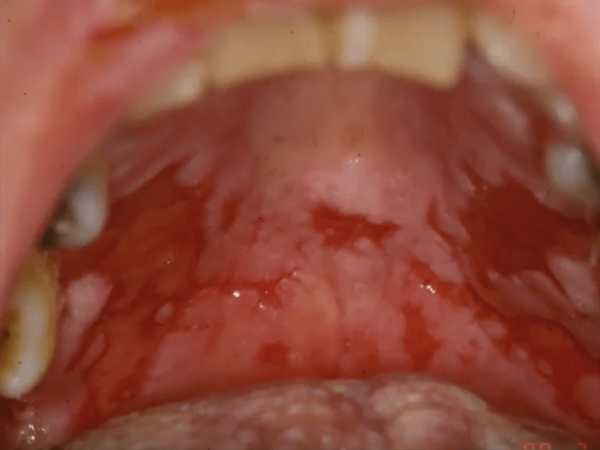
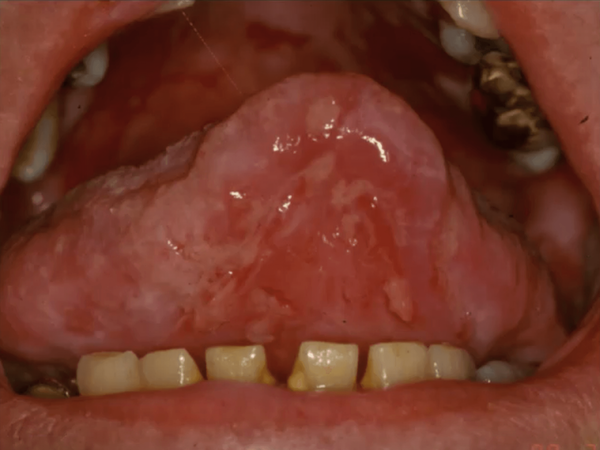
The first thing when I see this is oh my gosh this looks very painful and so you see these diffuse ulcerative lesions of the hard and soft palate and pharyngeal area.
You can see diffuse ulcerations of the pseudomembrane of the ventral tongue. It is probably focused here because it is subject to friction or trauma with the teeth. You can also get a sense of a lesion on the retromolar pad area and so diffuse involvement.
Clinical Testing for Pemphigus Vulgaris
One of the clinical tests that you can do, although it might cause pain to the patient, is something called a Nikolsky Sign.
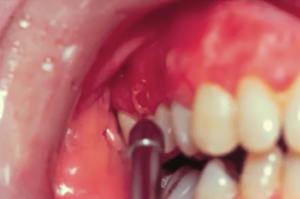
A Nikolsky Sign is when you’re applying air or lateral pressure to an area to see if you can induce sloughing, a vesicle, or bullae.
I’ve done this a couple times just you know out of curiosity to see if the patient might have pemphigus or pemphigoid, but it’s not something that I recommend doing extensively.
One time I was taking a biopsy and it’s just you know pushing air in the area and it caused a huge vesicle I guess a huge bullae and it was very alarming.
Pictures of Pemphigus Vulgaris Mucocutaneous Conditions
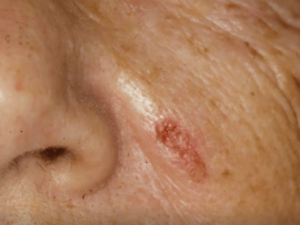
These are mucocutaneous conditions which can involve the oral cavity or any mucous membrane site, including the skin. This is an example of pemphigus vulgaris localized to the skin.
So without the remaining clinical picture this just looks like an ulceration maybe something in your differential might be a squamous cell or basal cell.
When you have diffuse ulcerative lesions involving other areas of the body you’ve got to start thinking about pemphigus.

This is a picture of localized pemphigus vulgaris. It looks very painful of diffuse involvement of the skin. We’ve got lesions that are at several different stages of their healing process.
We see a fresh lesion with underlying denuded connective tissue and the epithelium is falling apart. We also have some crusted lesions a further on in the healing process.
Pemphigus Vulgaris Diagnosis
Where do we find them in patients?
- soft palate
- buccal mucosa
- ventral tongue
- lower lip
- gingiva
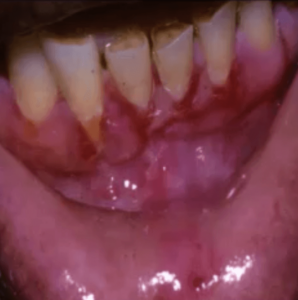
We usually see them in adults usually greater than 40 years of age and there’s no race or gender predilection.
Usually, these patients will come with a several month history of lesions and so it can be a slow onset with painful erosions and alterations.
Early diagnosis of Pemphigus Vulgaris is something we try to achieve in patients because the oral lesions are the first show and last to go.
If you can catch and make the diagnosis early, you can potentially prevent skin lesions, which is why Pemphigus Vulgaris is something that you need to have on your radar.
Pemphigus Vulgaris Histology
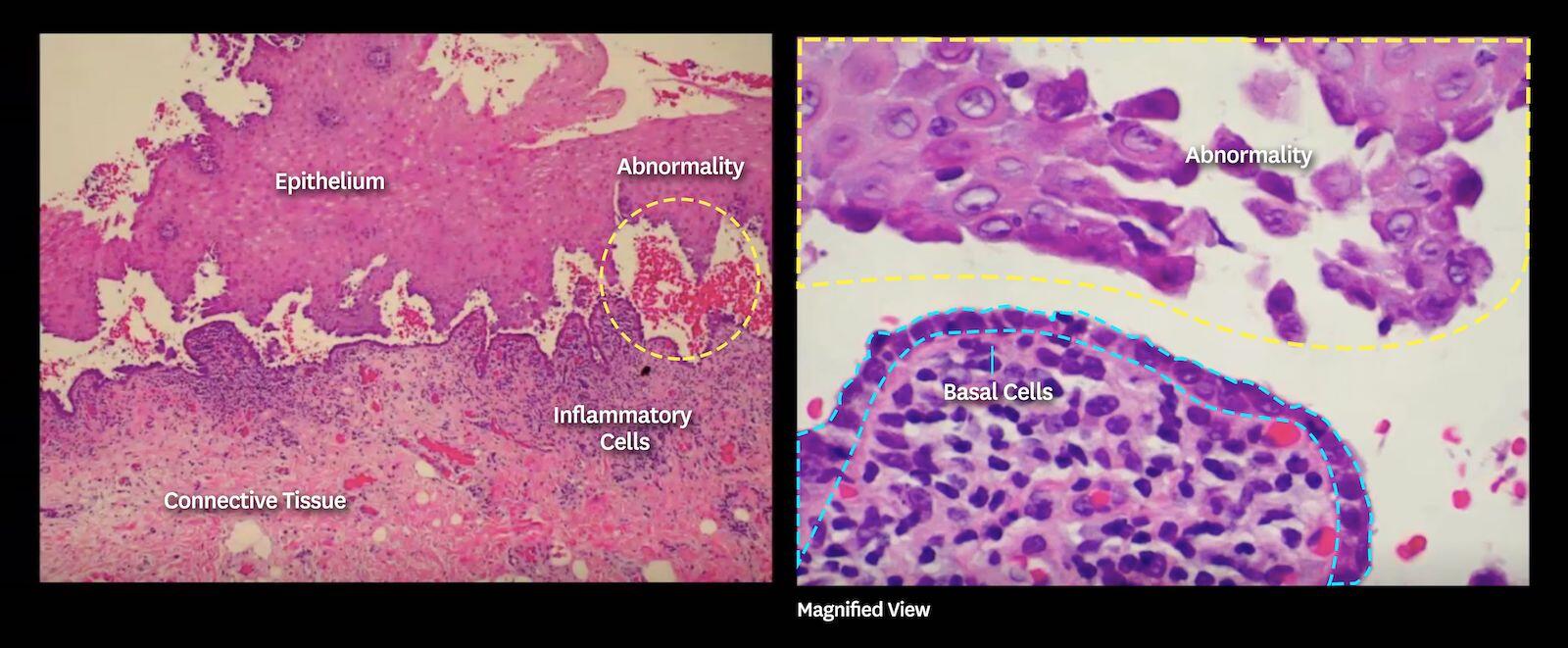
This is what the histologic picture of Pemphigus Vulgaris looks like. We’ve got our epithelium, we’ve our connective tissue, and the inflammatory cells. The abnormality is located between the epithelial cells.
It looks like it may be between the connective tissue and the epithelium, but if you look closely in the magnified view you can see that there are these basal cells of the epithelium that are still attached to the connective tissue.
The basal cells of the epithelium are connected through the basement membrane to the underlying connective tissue which is pretty chronically inflamed. We can see the abnormality and cells that are falling apart. Because these cells are compromised desmosomes the epithelium just falls apart.
Pemphigus Vulgaris Treatment
- Systemic steroid therapy
- Establish excellent Oral Hygiene and plaque control to reduce gingival inflammation
Pemphigus Vulgaris can be treated systemically. In the past, they’ve used steroids most frequently, but now they’re starting to use more steroid-sparing agents because there are so many complications with long-term steroid use.
Another thing that’s important is that these patients need to control their oral hygiene. Make sure that it is excellent because inflammation, plaque, and calculus can exacerbate the lesions.
Pemphigus Vulgaris Prognosis
- Cure is likely, good control is ideal
- Before or after steroid therapy
- Do not delay, it can be fatal!
Pemphigus Vulgaris is not something that’s cured. Managing Pemphigus Vulgaris and good control is what we’re trying to achieve. Before steroid therapy, these patients, like 90% of them, died from the pemphigus conditions. After a steroid therapy and steroid-sparing agents, the survival rate is lot better. Usually, these patients will succumb to the secondary effects of the medication as opposed to the disease itself.
So if you are suspecting Pemphigus Vulgaris, you need to take a biopsy. For biopsies of vesicular ulcerative conditions, you want to include perilesional tissue and the lesional tissue. This is really really important. We need to see the separation where the vesicle is forming in order to make the diagnosis.
Postgraduate Oral Pathology and Radiology Certificate
Learn more about the clinical and didactic skills necessary to evaluate and manage patients with oral diseases by enrolling in Herman Ostrow School of USC’s online, competency-based certificate program in Oral Pathology and Radiology.

